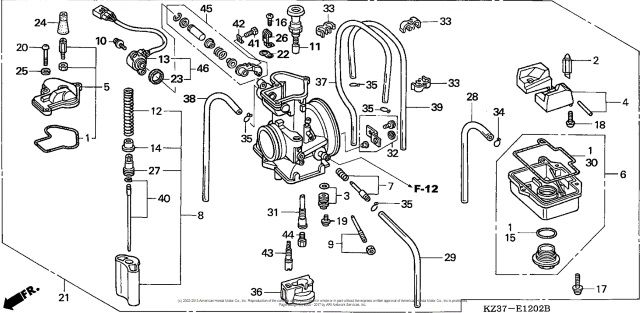
The sputtering dirt bike, a lean running engine or, even worse, the non-starter leads many DIY mechanics down numerous rabbit holes for the fix.
But, before heading through those darkened trails check the fuel line. Fuel, or lack of it, often presents as the common culprit for performance issues or dead engines and it's generally a cinch to repair.
The most common fuel line problems for 2-strokes and older model 4-strokes without fuel injection include:
- Clogged fuel line
- Old or damaged fuel line
- Kinked fuel line
A quick inspection should reveal rather quickly if you have a fuel line problem. You won't need to remove anything, just check the inner belly of your dirt bike and follow the fuel line where it connects to the carburetor with your hands.
Brittle or damaged fuel lines frequently drip but depending on the severity and how often you ride, gas from a leak might evaporate before puddling on the ground. However, damp exit and entry points offer a solid clue and hardened or brittle lines require replacing regardless of leaks. Clips secure the fuel line to the gas tank and carb therefore those require inspection. A damaged clip also allows fuel to leak.
Like any part, age eventually gets the best of a fuel line or the clips and incorporating a fuel line check into regular maintenance is a good idea as your dirt bike gets older and after an accident. Old, cracked or damaged fuel lines or clips need replacing.
A kinked fuel line results from bad installation, a crash or even the track ghost. Seriously, sometimes it just happens and we'll never know why. Looking at the fuel line you'd wonder how it manages to kink and swear someone was messing with your ride. But time and travel somehow allow hoses and cables to experience the most implausible twisting and bending. If the line is kinked, work it free! Sometimes however, the kink either damaged the hose or won't work completely out. You'll need to replace it.
*New fuel lines and clips available as OEM only.
A clogged fuel line is the hardest to diagnose because a small pebble lodges anywhere from the fuel tank to the carburetor. As you work your fingers along the fuel line, gently squeeze to feel for any obstructions. If you find an obstruction remove the hose and use compressed air to flush it out. Also, check the entry from the fuel tank into the line for larger pieces of debris preventing fuel from passing through.
A standard diagram of the carburetor: Fuel Line (#38) and Clip (#35)
How to Remove Fuel Line
So how do you remove the fuel line? Especially without spilling gas everywhere? First turn your dirt bike upside down to empty the gas tank. OK, kidding. Just turn off the fuel petcock. This prevents the gas from pouring out after removing the fuel line. Don't FORGET to do this. You'll dump gas everywhere and have a toxic reminder for weeks on end.
After you've TURNED OFF the petcock, grab a set of pliers and:
- Remove the clips from the fuel tank and carburetor (use the pliers)
- Replace the hose if necessary or use the air to blow it out
- Reinstall the line or replace, and add the clips using the pliers (so much easier!)
- Turn on the petcock
Start your dirt bike.
If the previously dead engine starts you've solved the problem. Same goes with sputtering or lean running though you'll probably want a test lap or two before declaring mission accomplished. If the same problems persist then down the rabbit holes you go.
Find a more detailed explanation of replacing the fuel line by reading How to Replace the Fuel Line in a Dirt Bike.
If addressing the fuel line fails to correct the issue check out Help! My Dirt Bike Won't Start. If it's a sputtering or lean running problem read A Simple Guide to Jetting Your Carb.









